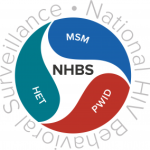What is National HIV Behavioral Surveillance (NHBS)?

National HIV Behavioral Surveillance (NHBS) is conducted by the Virginia Department of Health (VDH) in the Norfolk-Newport News-Virginia Beach Metropolitan Statistical Area (Norfolk MSA, locally referred to as Hampton Roads MSA) in conjunction with the Centers for Disease Control and Prevention (CDC). As one of 22 selected project areas with high prevalence of HIV, Hampton Roads MSA seeks to learn more about the behaviors of people at increased risk of acquiring HIV.
The aim of NHBS is to help state and local health departments establish and maintain a surveillance system to monitor selected risk behaviors, HIV testing, prevention services, and HIV prevalence among groups at highest risk for HIV infection.
Program Significance
The ongoing and systematic data collection of NHBS provides necessary data to monitor and evaluate national HIV prevention goals, as well as guide national and local HIV prevention efforts. NHBS data may contribute to the identification of HIV prevention needs and improvement of prevention programs directed to the populations at highest risk for HIV infection.
Program Procedures
NHBS data collection occurs in annual cycles, rotating between three different populations at increased risk for HIV infection:
- Gay, bisexual, and other men who have sex with men (MSM cycle)
- Persons who report injection drug use (IDU cycle)
- Heterosexuals at increased risk for HIV infection (HET cycle)
During the MSM cycle, participants are recruited using venue-based, time-space sampling (VBS), in which staff identify venues frequented by MSM and times men often visit the venues. During the IDU and HET cycles, participants are recruited using respondent-driven sampling (RDS), in which staff select a small number of initial participants (“seeds”) who complete the survey and then recruit their peers to participate.
In all three cycles, trained interviewers screen participants for eligibility and use a standardized, anonymous questionnaire to collect data. The interview takes approximately 30-40 minutes to complete and includes questions concerning HIV-related risk behaviors, HIV testing, and the use of HIV prevention services. Additionally, all participants are offered an anonymous HIV test and are compensated for their time. Data collection continues until the desired sample size of 500 completed interviews of eligible persons is met for each cycle.
Participation
Participation in NHBS is completely voluntary. The success of NHBS depends on the successful recruitment and participation of eligible participants to achieve the desired sample size in each cycle.
Confidentiality
NHBS is covered under the Assurance of Confidentiality for HIV/AIDS Data. Participation in NHBS is anonymous, meaning participants are not required to provide their names or other personal identifiers and NHBS forms are linked by Survey ID numbers only. Additionally, protocols are strictly followed to ensure the integrity, confidentiality, and security of all NHBS data.
Additional Resources
Summary Reports
- *NEW (as of March 2023)* HIV Infection, Risk, Prevention, and Testing Behaviors Among Men Who Have Sex with Men: National HIV Behavioral Surveillance in Hampton Roads Metropolitan Statistical Area, 2021
- HIV Infection, Risk, Prevention, and Testing Behaviors Among Heterosexuals at Increased Risk of HIV Infection: National HIV Behavioral Surveillance in Hampton Roads Metropolitan Statistical Area, 2019
- HIV Infection, Risk, Prevention, and Testing Behaviors Among Persons Who Inject Drugs: National HIV Behavioral Surveillance in Norfolk-Newport News-Virginia Beach Metropolitan Statistical Area, 2018
- HIV Infection, Risk, Prevention, and Testing Behaviors Among Men Who Have Sex with Men: National HIV Behavioral Surveillance in Norfolk-Newport News-Virginia Beach Metropolitan Statistical Area, 2017
Fact Sheets
- 2021 Hampton Roads MSA NHBS MSM Fact Sheet: Interview Data Summary
- 2019 Hampton Roads MSA NHBS HET Fact Sheet: Interview Data Summary
- 2018 Norfolk MSA NHBS PWID Fact Sheet: Interview Data Summary
- 2017 Norfolk MSA NHBS MSM Fact Sheet: Interview Data Summary
Infographics
CDC Website
You can also read more about NHBS at the CDC’s website:
https://www.cdc.gov/hiv/statistics/systems/nhbs/index.html
Last updated: March 27, 2023

